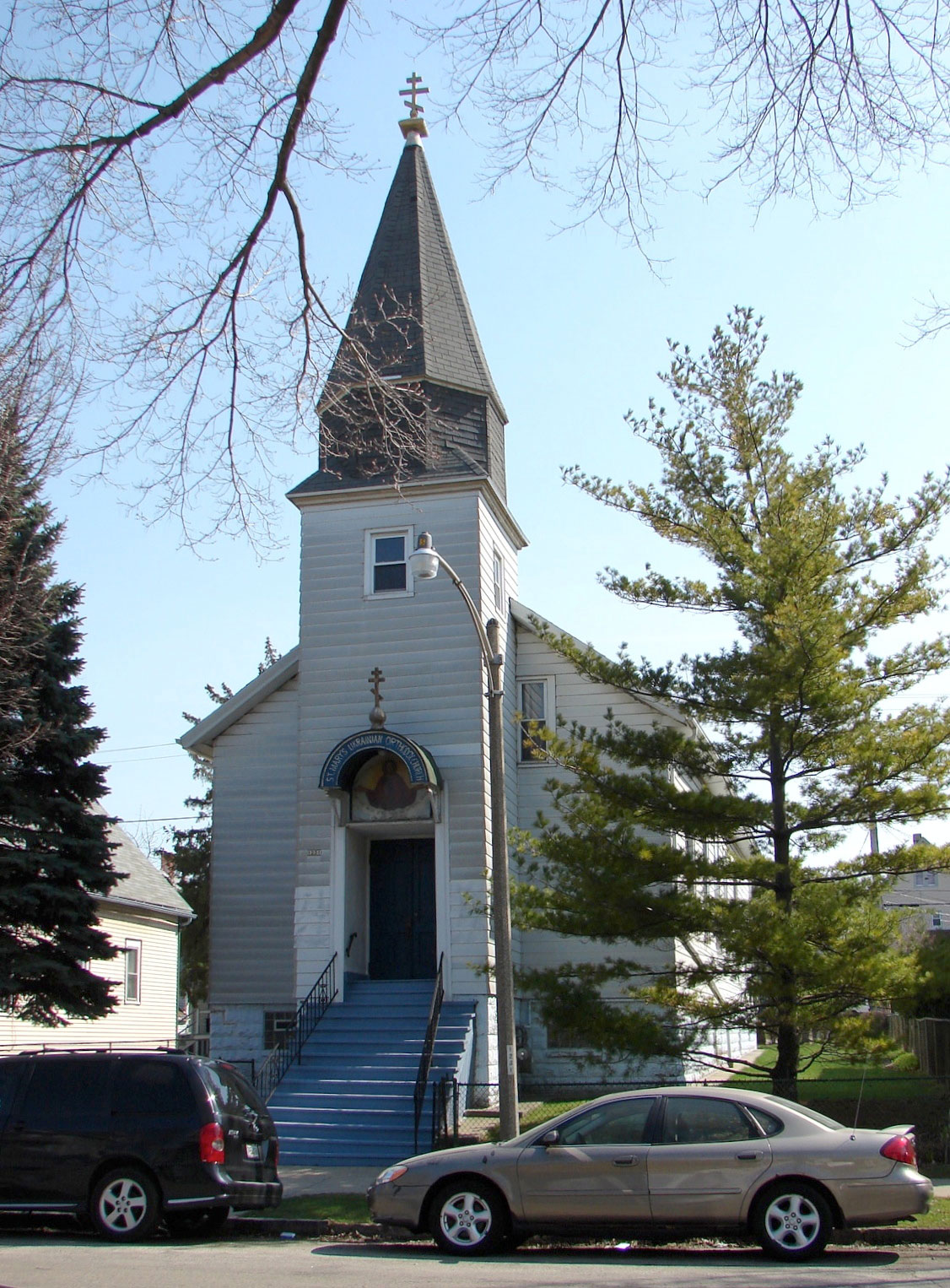61. Our Savior’s Lutheran, 1952
3022 West Wisconsin Avenue
Architect: Hugo Haeuser
Our Savior’s Lutheran is a transitional church design. Although it conforms to no historical revival style, the building’s overall form and proportions are similar to many of the city’s earlier Romanesque Revival and Gothic Revival churches. The church has a prominent tower and spire that reach a height of 120 feet, but the design is simplified and modern in appearance compared to the towers and spires of older churches.
A distinctly modern feature is the high-relief sculpture of “The Inviting Christ” above the entrance. Milwaukee sculptors Adolph Roegner and Dick Wiken created the 15-foot tall figure. Both men did architectural stone carving for numerous buildings in the Milwaukee area. Although architects working in the modern style shunned the use of traditional ornament, this form of sculpture did achieve a degree of popularity in the 1950s and 1960s. There are four other churches in Milwaukee with façade sculptures that are larger than life-size, depicting either the adult Jesus or Mary holding the infant Jesus. Our Savior’s Lutheran is the earliest of these.
Like the exterior, the interior of the church is traditional in its form and proportions. The tall and relatively narrow nave, with its vaulted ceiling and axial orientation, recalls the city’s earlier Romanesque Revival churches. At the same time, the interior is contemporary in its materials and lack of ornament, with the structural concrete left exposed in the modern manner. With seating for more than 1,000 worshipers, Our Savior’s Lutheran is one of the largest Protestant churches built in Milwaukee during the first decades after World War II.
Construction of the church began in 1951, based on plans by the Milwaukee architect and church specialist Hugo Haeuser. Completion of the building took longer than expected due to a shortage of steel for civilian uses during the Korean War, with the first service in the finished church conducted on Easter morning in April of 1954. This was one of Haeuser’s most modern church designs, and also one of his last. The architect died shortly after construction began, at age 69, and the congregation turned to the Milwaukee firm of Grassold and Johnson to take over the commission and supervise the building’s completion. The church appears today essentially as constructed in the early 1950s, except that the solar panels on the façade were installed in 2008.
Our Savior’s Lutheran traces its origins to a Norwegian immigrant church established in the late 1850s. Immigrants from Denmark, Norway, and Sweden formed the Scandinavian Lutheran Church in 1852, located in the Walker’s Point neighborhood on the South Side. However, the lack of a common language and differences in the traditional religious services of each nationality prompted some of the Norwegians to form a separate church in 1858. The congregation built a wooden church of modest size in 1859, on Lapham Boulevard between 7th and 8th Streets. In 1868, they had the building moved about six blocks to the corner of 5th and Scott Streets. This church was subsequently moved again by different owners, to its present location on Scott between 12th and 13th Streets, and now serves as St. Mary’s Ukrainian Orthodox Church. It is the city’s oldest surviving wooden church.

While at its second location at 5th and Scott Streets, the congregation adopted the name Our Savior’s Lutheran, after the cathedral in Oslo, Norway (now known simply as Oslo Cathedral). The congregation built a larger brick church in 1894, at 9th and Scott Streets, which served until completion of the present church in the early 1950s. The 1894 church also remains standing, and is currently used by a Spanish-language Protestant congregation.
English-language services began at Our Savior’s Lutheran in the early twentieth century. By the late 1920s, most services were conducted in English, and church records were being kept entirely in English by the end of the decade. However, regular services in Norwegian continued into the early 1940s, with some Norwegian services on special occasions thereafter.
In the years following World War II, the city’s cohesive and even insular ethnic neighborhoods were in transition, as the more assimilated younger generations dispersed to newer and more distant neighborhoods as well as to the suburbs. By the time the congregation of Our Savior’s decided to leave the South Side and build its present church, regular services were being conducted exclusively in English. There were probably few members who regularly spoke Norwegian by this time, and none who could not also speak English. The location selected for the present church, a short distance west of downtown on the city’s main commercial street, was in part a deliberate attempt to draw new members from a larger geographical area, rather than serving a particular neighborhood or ethnic group.
Sources:
Buck, Diane M. and Virginia A. Palmer. Outdoor Sculpture in Milwaukee: A Cultural and Historical Guidebook. State Historical Society of Wisconsin, 1995.
Ladd, Ann. The Church of the Inviting Christ: 125 Years in the Life of Our Savior’s Lutheran Church, Milwaukee, Wisconsin. Our Savior’s Lutheran Church, c. 1985.
Our Savior’s Lutheran Church. Newspaper clippings file, Milwaukee Central Library, Humanities Room.

